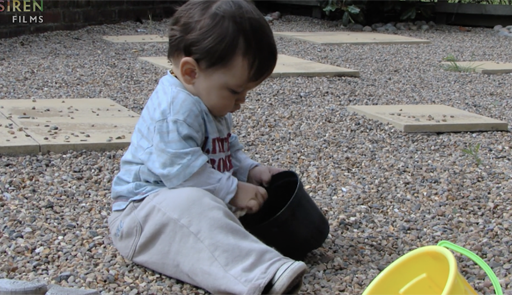2.3 The young explorer
In this section you are going to look more closely at a young child, Liam, exploring his outdoor environment.
Activity 2 The young explorer
Read the quotation below from Watts (2011) about what constitutes effective surfaces and stimuli for babies and young children.
… younger babies are often calmed by the movement of leaves and trees and will respond to different textures of plants around them. As they become more mobile, consider whether you can present changes in floor levels, a small slope, stepping stones sunk into the ground or low-level steps. Different floor textures could be used for different parts of a ‘baby space’. Toddlers enjoy moving things around and will become totally absorbed by a muddy puddle or some large pebbles. Long grass provides a different experience and also an area of moss gives another interesting texture. Raised grassy banks, logs or sunken tyres can give opportunities for babies to pull themselves up. They need to be able to explore, to walk or crawl into small spaces. Think about bamboo screens or bushes that give this hideaway feel.
Now watch this video. Liam, a 13-month-old boy, explores his local outdoor space as the commentator highlights Liam’s learning. As you watch focus on how Liam is exploring and using his environment. What evidence do you see that fits with Watts’ quotation about what outdoor spaces for children should contain? What do you think could enhance Liam’s outdoor environment even more? Don’t forget to record your responses in your Learning journal or text box below.

Transcript
SPEAKER 1: Development of the brain and body are completely inseparable. It's through their actions that toddlers build up their patterns of thought. Liam likes filling containers with gravel and emptying them out again. He does it over and over again.
He's beginning to understand that containers are fillable. They have openings at the top where you can put things in. It's a concept he's noticed, and he's testing it out in different contexts. He could put big stones and his whole body in the washing up bowl.
SPEAKER 2: [INAUDIBLE] nice.
SPEAKER 1: He's interested in the little holes where he can fit his fingers in. Through these repetitive actions putting objects or himself in and out, he's testing how the world works. Is it the same if I do it over here? Is it the same if I put my whole body in? These patterns of thought are often referred to as schemas.
At this age, these schemas are embedded in their movements and actions. Liam's movements are vital for developing his intellectual skills, and this is how his thinking develops.
Adults might look at this potholed back lane and want to cover it with a new layer of smooth tarmac, cut back the bushes, neaten and organise everything, make it safe. But for Liam, this unstructured diverse space is full of potential discoveries to be made.
Like most toddlers, he seems to have an inbuilt drive to want to find out everything he can about what things are like and what they can do. He needs to continue with his current interest, and straight away spots a drain that's just right for posting stones through the holes. It's often little things that adults don't notice anymore that interest toddlers the most.
Just like in the front garden, he repeats the same actions over and over again. He prefers to explore things that can be moved and transformed, things he can have an effect on.
SPEAKER 2: Pick smaller.
SPEAKER 1: Mum encourages his exploration, helping him choose some stones that will fit down the holes.
SPEAKER 2: Thank you.
SPEAKER 1: He's discovered his own shape sorter. He's learning so much about sizes, shapes, materials, and gravity. He's slowly creating a feeling for some of the laws about the world.
Objects fall to the ground. Stones are hard. They can't be squeezed into a space which is smaller than they are. This is big and that smaller. He's got a real purpose. For Liam, this is important work. Moving down the street, he spots another hole. Look at this, Mum. He's curious and observant, keen to notice the similarities between certain things.
Comment
You might have noticed that, just as Watts (2011) suggested, Liam explores different floor textures like gravel and cracked tarmac which offers opportunities for exploration and changes in floor levels. Watts argued that toddlers enjoy moving things around; you might have spotted how Liam is enthralled in moving the pieces of gravel and tarmac around and becomes absorbed by the iron grate in the alleyway. She also suggests that they like to explore small spaces; Liam explores the small space of the washing up bowl by getting inside, and shows curiosity in the water gully too by dropping pebbles into it. To enhance Liam’s outdoor experience, he could be guided to explore the bushes in the back lane to give him the opportunity to hideaway, too.
